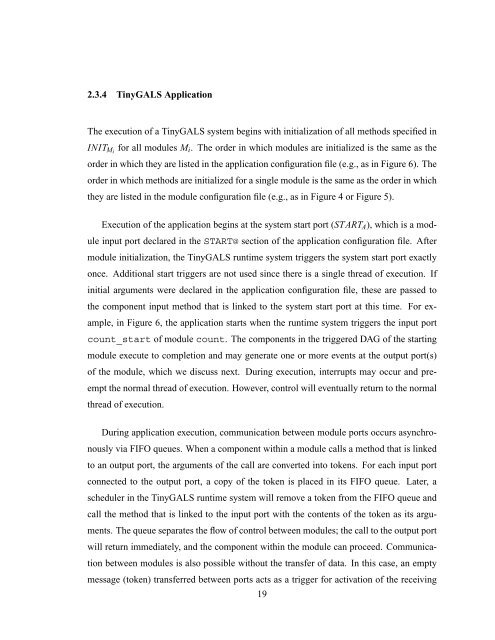Design and Implementation of TinyGALS: A Programming Model for ...
Design and Implementation of TinyGALS: A Programming Model for ...
Design and Implementation of TinyGALS: A Programming Model for ...
You also want an ePaper? Increase the reach of your titles
YUMPU automatically turns print PDFs into web optimized ePapers that Google loves.
2.3.4 <strong>TinyGALS</strong> Application<br />
The execution <strong>of</strong> a <strong>TinyGALS</strong> system begins with initialization <strong>of</strong> all methods specified in<br />
INITMi <strong>for</strong> all modules Mi. The order in which modules are initialized is the same as the<br />
order in which they are listed in the application configuration file (e.g., as in Figure 6). The<br />
order in which methods are initialized <strong>for</strong> a single module is the same as the order in which<br />
they are listed in the module configuration file (e.g., as in Figure 4 or Figure 5).<br />
Execution <strong>of</strong> the application begins at the system start port (STARTA), which is a mod-<br />
ule input port declared in the START@ section <strong>of</strong> the application configuration file. After<br />
module initialization, the <strong>TinyGALS</strong> runtime system triggers the system start port exactly<br />
once. Additional start triggers are not used since there is a single thread <strong>of</strong> execution. If<br />
initial arguments were declared in the application configuration file, these are passed to<br />
the component input method that is linked to the system start port at this time. For ex-<br />
ample, in Figure 6, the application starts when the runtime system triggers the input port<br />
count_start <strong>of</strong> module count. The components in the triggered DAG <strong>of</strong> the starting<br />
module execute to completion <strong>and</strong> may generate one or more events at the output port(s)<br />
<strong>of</strong> the module, which we discuss next. During execution, interrupts may occur <strong>and</strong> pre-<br />
empt the normal thread <strong>of</strong> execution. However, control will eventually return to the normal<br />
thread <strong>of</strong> execution.<br />
During application execution, communication between module ports occurs asynchro-<br />
nously via FIFO queues. When a component within a module calls a method that is linked<br />
to an output port, the arguments <strong>of</strong> the call are converted into tokens. For each input port<br />
connected to the output port, a copy <strong>of</strong> the token is placed in its FIFO queue. Later, a<br />
scheduler in the <strong>TinyGALS</strong> runtime system will remove a token from the FIFO queue <strong>and</strong><br />
call the method that is linked to the input port with the contents <strong>of</strong> the token as its argu-<br />
ments. The queue separates the flow <strong>of</strong> control between modules; the call to the output port<br />
will return immediately, <strong>and</strong> the component within the module can proceed. Communica-<br />
tion between modules is also possible without the transfer <strong>of</strong> data. In this case, an empty<br />
message (token) transferred between ports acts as a trigger <strong>for</strong> activation <strong>of</strong> the receiving<br />
19
















